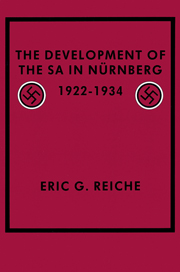Book contents
- Frontmatter
- Contents
- List of tables, figures, and maps
- Acknowledgments
- Introduction
- Abbreviations
- 1 Nürnberg and the emergence of National Socialism
- 2 Enter the stormtroopers: the Nürnberg SA, 1922–1923
- 3 “The guarantor of unity”: Nürnberg's SA between 1924 and 1929
- 4 Ready to assume power: the SA during the Great Depression
- 5 “The party bosses are our misfortune”: the Stegmann revolt, November 1932 to March 1933
- 6 The illusion of power: from the advent of the Third Reich to the Röhm putsch
- Conclusion
- Notes
- Bibliography
- Index
5 - “The party bosses are our misfortune”: the Stegmann revolt, November 1932 to March 1933
Published online by Cambridge University Press: 21 October 2009
- Frontmatter
- Contents
- List of tables, figures, and maps
- Acknowledgments
- Introduction
- Abbreviations
- 1 Nürnberg and the emergence of National Socialism
- 2 Enter the stormtroopers: the Nürnberg SA, 1922–1923
- 3 “The guarantor of unity”: Nürnberg's SA between 1924 and 1929
- 4 Ready to assume power: the SA during the Great Depression
- 5 “The party bosses are our misfortune”: the Stegmann revolt, November 1932 to March 1933
- 6 The illusion of power: from the advent of the Third Reich to the Röhm putsch
- Conclusion
- Notes
- Bibliography
- Index
Summary
On January 30, 1933, Hitler became chancellor of Germany. Two months earlier, many leading party members had been in despair as the party faced serious financial difficulties and a great deal of dissatisfaction among its members. On November 6, 1932, German voters had dealt the NSDAP a substantial defeat. Nationally, its share of the vote sank from 37.2 to 33.1 percent, reducing the number of its Reichstag members from 230 to 196. Equally troublesome were the financial worries that, according to Goebbels, “made all well-directed work impossible.” To confound the situation, Gregor Strasser, the party's chief administrator, resigned from the party on December 7, thus momentarily confronting Hitler with the danger that disaffected party members might rally around Strasser.
Nowhere was dissatisfaction at the end of 1932 more evident than in the SA. The situation reports Röhm had received from SA units across Germany in September had already revealed the considerable disappointment within the SA with Hitler's policies. The outcome of the November elections added to the discontent, and by early December even Hitler's personal appeal showed occasional signs of weakening. When he addressed party functionaries in Halle on December 17, Hitler had to witness an ignominious spectacle. While he was greeting his officials in the front rows of the auditorium, rebellious SA and SS men vented their frustrations in the back of the room. The Central Franconian Communist newspaper, Die Neue Zeitung, reported in mid-December on a mutiny among SA units in the Kassel area, where two entire SA storm units had allegedly left the party after the removal of some local SA leaders.
- Type
- Chapter
- Information
- The Development of the SA in Nurnberg, 1922–1934 , pp. 146 - 172Publisher: Cambridge University PressPrint publication year: 1986



